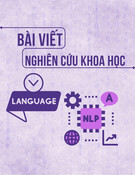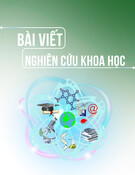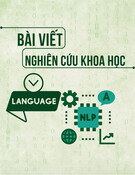
TNU Journal of Science and Technology 230(04): 241 - 247
http://jst.tnu.edu.vn 241 Email: jst@tnu.edu.vn
ENHANCING NON-ENGLISH MAJOR STUDENTS’ SPEAKING SKILLS:
THE ROLE OF AI TOOLS IN SELF-LEARNING AT A UNIVERSITY IN HANOI
Nguyen Thi Thu Thuy
*
Hanoi University of Civil Engineering
ARTICLE INFO ABSTRACT
Received:
21/02/2025
This study investigated the application of artificial intelligence
tools in
enhancing the speaking skills of non-
English major students at a
university in Hanoi -
Hanoi University of Civil Engineering. The study
employed a mixed-
methods approach, including experiments, surveys,
and interviews to evaluate the impact of AI tools such as speech
recognition and feedback systems. Data were collected from 120
students who used AI-based tools for self-learning over a three-
month
period. The results showed that students using AI tools demonstrated
significant improvements in pronunciation accuracy, fluency, and
learner confidence with an average increase of 20% in the oral
proficiency test scores. Moreover, students reported enhanc
ed
motivation and confidence in speaking English. The findings suggested
that AI tools played a crucial role in overcoming language barriers and
facilitating autonomous learning. This study contributed to the
understanding of integrating AI in language edu
cation and highlighted
the potential for further applications in other skill areas.
Revised:
10/04/2025
Published:
13/04/2025
KEYWORDS
Self-learning
AI tools
Speaking skills
Non-English major students
Pronunciation accuracy, fluency
and learner confidence
NÂNG CAO KỸ NĂNG NÓI CỦA SINH VIÊN KHÔNG CHUYÊN ANH:
VAI TRÒ CỦA CÁC CÔNG CỤ AI TRONG TỰ HỌC
TẠI MỘT TRƯỜNG ĐẠI HỌC Ở HÀ NỘI
Nguyễn Thị Thu Thủy
Trường Đại học Xây dựng Hà Nội
THÔNG TIN BÀI BÁO TÓM TẮT
Ngày nhậ
n bài:
21/02/2025
Nghiên c
ứu n
ày đi
ều tra việc ứng
d
ụng các công cụ trí tuệ nhân tạo
trong việc nâng cao kỹ năng nói của sinh viên không chuyên ti
ếng
Anh tại một trường đại học ở Hà Nội – Trường Đại học Xây dựng H
à
Nội. Nghiên cứu sử dụng phương pháp h
ỗn hợp, bao gồm khảo sát,
phỏng vấn và thực nghiệm nhằm đánh giá tác đ
ộng của các công cụ
AI như nhận diện giọng nói và hệ thống phản hồi. Dữ liệu đư
ợc thu
thập từ 120 sinh viên đã s
ử dụng các công cụ AI để tự học trong thời
gian ba tháng. Kết quả cho thấy sinh viên s
ử dụng công cụ AI có sự
cải thiện đáng kể về độ trôi chảy và đ
ộ chính xác phát âm, với mức
tăng trung bình 20% trong điểm bài kiểm tra năng lực nói. Hơn n
ữa,
sinh viên cũng báo cáo sự gia tăng động lực và s
ự tự tin khi nói tiếng
Anh. Những phát hiện này cho th
ấy rằng các công cụ AI có thể đóng
vai trò quan trọng trong việc vượt qua rào cản ngôn ngữ và h
ỗ trợ học
tập tự chủ. Nghiên cứu này đóng góp vào việc hiểu rõ hơn v
ề việc
tích hợp AI trong giáo dục ngôn ngữ và nh
ấn mạnh tiềm năng ứng
dụng rộng rãi trong các kỹ năng khác.
Ngày hoàn thiệ
n:
10/04/2025
Ngày đăng:
13/04/2025
TỪ KHÓA
Tự học
Công cụ trí tuệ nhân tạo
Kỹ năng nói
Sinh viên không chuyên tiế
ng
Anh
Độ chính xác phát âm, độ
trôi
chảy và sự tự tin của người học
DOI: https://doi.org/10.34238/tnu-jst.12109
Email: nguyenworkaholic@gmail.com

TNU Journal of Science and Technology 230(04): 241 - 247
http://jst.tnu.edu.vn 242 Email: jst@tnu.edu.vn
1. Introduction
In recent years, self-learning has gained increasing attention as an essential approach for
language acquisition, especially among non-English major students. The self-learning process is
a learning method in which students take the initiative in acquiring knowledge and skills without
direct supervision, relying on digital tools, self-assessment, and independent practice. However,
non-English major students face significant challenges in developing their speaking skills
through self-learning.
Speaking skills, in the context of this study, consist of three key components: pronunciation,
fluency, and learner confidence. Pronunciation refers to the accuracy of articulating words and
sounds, fluency is the ability to speak smoothly and coherently, and learner confidence represents
the level of self-assurance in speaking English. These factors play a crucial role in effective
verbal communication and are often the primary areas of difficulty for self-learning students.
Many students struggle with pronunciation due to the influence of their native language,
leading to mispronunciations and incorrect stress patterns, which hinder effective communication
[1]. Additionally, the absence of direct feedback from instructors or native speakers makes it
difficult for students to correct errors and improve their pronunciation skills [2].
Furthermore, self-learning students often lack a suitable environment for speaking practice. In
traditional classroom settings, students have opportunities to interact with peers and instructors,
but self-learners may not have access to structured speaking practice opportunities. Without
conversation partners, they may resort to passive learning methods such as listening or reading
rather than engaging in verbal communication activities. This limitation significantly impacts
their ability to develop fluency [3].
Another common challenge is the lack of confidence in speaking English. Many non-English
major students feel anxious or hesitant when speaking due to fear of making mistakes, negative
self-perceptions, or lack of exposure to real-life communication situations. Psychological barriers
such as speaking anxiety and low self-confidence significantly hinder students’ ability to
communicate effectively [4]. This lack of confidence often leads to avoidance of speaking
practice, slowing down the improvement of fluency and pronunciation. The absence of
systematic guidance and real-time feedback further exacerbates these issues, making it difficult
for students to achieve fluency and accuracy in spoken English [5].
Given these challenges, technological advancements, particularly AI-powered tools, offer
promising solutions to enhance speaking skills for self-learners. AI-powered tools, such as
Duolingo and ELSA Speak, offer real-time feedback on pronunciation, fluency, and intonation,
potentially addressing some of the barriers faced by self-learning students [6]. Research has shown
that AI-powered applications, such as ELSA Speak, can significantly improve pronunciation skills
among language learners [7]. However, despite the growing adoption of AI in education, there
remains a lack of empirical research investigating the extent to which these tools improve speaking
skills, particularly in the context of non-English major students in Vietnam.
The primary objective of this study was to evaluate the effectiveness of AI-powered language
learning tools in improving pronunciation, fluency, and learner confidence among non-English
major students. Specifically, this study sought to determine whether these tools could effectively
enhance self-directed speaking practice and address key challenges faced by learners. By doing
so, the research contributed to a better understanding of the role of AI in fostering self-learning
and improving speaking performance. Building on these discussions, this study sought to address
a key research question: To what extent do AI tools improve pronunciation, fluency, and
confidence in the self-learning process of non-English major students?
To achieve these objectives, a mixed-methods approach was employed, incorporating
experimental research, surveys, interviews, and AI usage data analysis. The study involved 120
non-English major students divided into an experimental group using AI-based learning tools and

TNU Journal of Science and Technology 230(04): 241 - 247
http://jst.tnu.edu.vn 243 Email: jst@tnu.edu.vn
a control group following traditional self-study methods. Pre- and post-tests were conducted to
measure improvements in speaking skills, and qualitative data from interviews were analyzed to
gain deeper insights into students’ experiences.
The remainder of this article is structured as follows: Section 2 describes the research
methodology, including participant selection, AI tool implementation, and data analysis techniques.
Section 3 presents the results and discusses their implications, comparing findings with prior
research. Finally, section 4 provides conclusions and suggests directions for future research.
2. Methods
This research employed a mixed-method approach to explore the impact of AI tools on
students’ speaking skills. The participants included 120 non-English major students from Hanoi
University of Civil Engineering, divided into experimental and control groups. The experimental
group used AI-based tools such as Duolingo’s speech recognition module and ELSA Speak,
while the control group relied on traditional self-learning methods. The study design incorporated
the following components:
2.1. Participants and sampling
A total of 120 students were randomly selected using a stratified random sampling method.
Participants were first categorized based on their English proficiency levels (determined through
a pre-test) and then randomly assigned to either the experimental group (60 students) or the
control group (60 students) using a computerized randomization tool. This ensured a balanced
distribution of proficiency levels across both groups.
2.2. AI tools and traditional methods
The experimental group utilized Duolingo and ELSA Speak for daily speaking practice. Both
tools have free and premium versions; for this study, students primarily used the free versions.
Duolingo’s speech recognition module provided pronunciation feedback, while ELSA Speak
offered real-time scoring and corrective feedback on pronunciation and fluency. Some students
voluntarily upgraded to the premium versions, which provided additional exercises and detailed
analytics, but this was not a requirement.
Students used their personal smartphones to access these AI tools, ensuring flexibility and
convenience. However, some students opted to use laptops for a better user experience,
particularly when engaging in structured practice sessions.
The AI tools covered various speaking topics, including everyday conversations, academic
discussions, and professional communication. The topics were carefully selected to align with the
university’s English curriculum, ensuring relevance to classroom learning. This alignment
allowed students to reinforce classroom knowledge through AI-assisted practice.
The control group followed a structured self-directed learning schedule, which required them
to engage in speaking practice using traditional methods, such as textbook exercises, peer
discussions, and audio-based repetition drills. They were expected to spend at least 30 minutes
daily practicing speaking skills, similar to the AI group. However, without real-time feedback,
their progress depended on self-evaluation and occasional peer corrections.
Both groups completed a pre-test and post-test to assess their speaking proficiency. The
speaking tests were designed based on the CEFR (Common European Framework of Reference
for Languages) guidelines and included three sections: (1) describing a picture, (2) answering
open-ended questions, and (3) engaging in a role-play conversation. The pre-test and post-test
were different but had equivalent levels of difficulty to ensure validity. Students’ responses were
recorded and evaluated by two independent raters.
To ensure interrater reliability, the raters were trained using a standardized rubric before
grading the tests. The interrater reliability score was calculated using Cohen’s kappa coefficient

TNU Journal of Science and Technology 230(04): 241 - 247
http://jst.tnu.edu.vn 244 Email: jst@tnu.edu.vn
to measure the level of agreement between raters. Any discrepancies in scoring were discussed
and resolved before finalizing the results.
2.3. Teacher supervision and AI usage monitoring
Teachers monitored both groups to ensure compliance with the learning schedule. Weekly
check-ins were conducted where students reported their practice hours and challenges. For the
experimental group, AI usage logs were reviewed to track engagement levels, including time
spent on the applications and lesson completion rates. This data helped assess whether AI tool
usage was consistent across participants.
To ensure consistency in self-directed learning, teachers provided structured guidelines for
both groups. The control group submitted weekly progress reports detailing their learning
activities, while the experimental group’s AI usage data was reviewed for adherence to the
prescribed learning schedule. Any discrepancies in usage levels were addressed through
reminders and additional support.
2.4. Data collection and analysis
Data were collected through pre- and post-tests, surveys, and interviews. The speaking
proficiency test evaluated fluency, pronunciation, and vocabulary usage. The survey measured
students’ confidence in speaking English before and after the intervention.
A 10-item Likert-scale survey was used to measure confidence levels in speaking English.
The survey focused on students’ self-perceived pronunciation accuracy, fluency, and comfort
when speaking in different contexts.
Semi-structured interviews were conducted with selected students from both groups to gather
qualitative insights into their learning experiences. The interview questions focused on their
perceived progress, challenges faced, and the effectiveness of AI tools compared to traditional
methods. A key concern was the variance in learning engagement among students. While most
students adhered to the 30-minute daily practice requirement, some engaged more frequently,
while others required reminders to maintain consistency. This variability was noted in the data
analysis to account for potential differences in learning outcomes.
By addressing these methodological aspects, this study ensured transparency and clarity in
the research design, providing a comprehensive understanding of AI’s role in self-directed
language learning.
2.5. Procedure
The study followed a structured, step-by-step procedure to ensure consistency among
participants. During the orientation phase, both groups attended an introductory session where the
study's purpose and expectations were explained. Participants in the experimental group received
the additional training on effectively using the AI tools.
The implementation phase lasted for 12 weeks. The experimental group was required to use
the AI tools for 30 minutes daily, focusing on speaking exercises, while the control group
adhered to a self-directed learning schedule using traditional resources. Weekly progress
meetings were conducted to resolve technical issues and encourage adherence to the study plan.
Throughout the feedback and monitoring phase, instructors tracked participants’ progress
through the weekly updates. AI tools’ feedback logs were reviewed to identify recurring
pronunciation challenges. In the testing and evaluation phase, all participants completed the oral
proficiency test both before and after the intervention. At the conclusion of the study, surveys were
distributed, and interviews were conducted with selected participants to gather further insights.
2.6. Data analysis
The analysis of data combined both quantitative and qualitative methods to provide a holistic

TNU Journal of Science and Technology 230(04): 241 - 247
http://jst.tnu.edu.vn 245 Email: jst@tnu.edu.vn
understanding of the study outcomes. Quantitative analysis included comparing pre- and post-test
scores using paired t-tests to identify statistically significant improvements in speaking
proficiency. Additionally, the improvement rates of the experimental and control groups were
compared using independent sample t-tests. Survey results were aggregated and analysed using
descriptive statistics to identify patterns and trends.
Qualitative analysis involved a thematic examination of interview transcripts to uncover
recurring themes such as motivation, confidence, and the usability of AI tools. Open-ended
survey responses were coded and integrated with interview findings, enabling a deeper
understanding of participants’ experiences and perspectives.
3. Results and Discussion
The study revealed that students in the experimental group achieved significantly higher
improvements in speaking proficiency compared to the control group. The average oral proficiency
test scores increased by 20%, with notable enhancements in pronunciation and fluency. This
significant improvement suggested that AI-powered tools provided structured, engaging, and
effective language practice that went beyond traditional self-directed learning methods.
3.1. Quantitative results
Table 1. Quantitative results
Aspect Experimental group
(AI-assisted learning)
Control group
(Traditional self-learning)
Average test score (Pre) 65 66
Average test score (Post) 78 70
Improvement (%)
20%
6%
Student Satisfaction (%)
85%
60%
Table 1 presented the pre-test and post-test scores for both groups. The experimental group
showed a significant improvement in speaking proficiency, with an average increase of 20% in
their test scores, while the control group exhibited a more modest 6% improvement. These results
indicated that AI-assisted learning substantially enhances language acquisition, particularly in
areas requiring real-time corrective feedback.
One possible explanation for the superior performance of the experimental group was the
immediate and targeted feedback provided by AI tools. Unlike traditional learning methods,
which often lacked instant correction, AI-powered speech recognition systems analyzed spoken
input in real-time and offered precise pronunciation adjustments. Studies by [6] and [8] supported
these findings, showing that AI tools reinforced accurate pronunciation and fluency by engaging
learners through adaptive feedback mechanisms.
Additionally, AI-driven gamification likely contributed to increased student motivation and
consistent practice. Features such as progress tracking, achievement badges, and interactive
exercises encouraged sustained engagement, making language learning more dynamic and
enjoyable. These motivational elements aligned with previous research by [9], which found that
gamified AI tools fostered long-term language retention and reduced learner anxiety.
While the control group also demonstrated some improvement, the relatively lower increase
suggested that traditional self-learning strategies might be less effective in addressing
pronunciation and fluency challenges. Without real-time corrective feedback and interactive
reinforcement, learners might struggle to recognize and correct their mistakes autonomously.
These findings highlighted the potential for AI to bridge critical gaps in conventional language
learning methodologies.
3.2. Qualitative insights
Qualitative insights from the interviews highlighted several important themes. Many












![Đề cương môn Tiếng Anh 1 [Chuẩn Nhất/Mới Nhất]](https://cdn.tailieu.vn/images/document/thumbnail/2025/20251130/cubabep141@gmail.com/135x160/51711764555685.jpg)










![Mẫu thư Tiếng Anh: Tài liệu [Mô tả chi tiết hơn về loại tài liệu hoặc mục đích sử dụng]](https://cdn.tailieu.vn/images/document/thumbnail/2025/20250814/vinhsannguyenphuc@gmail.com/135x160/71321755225259.jpg)


